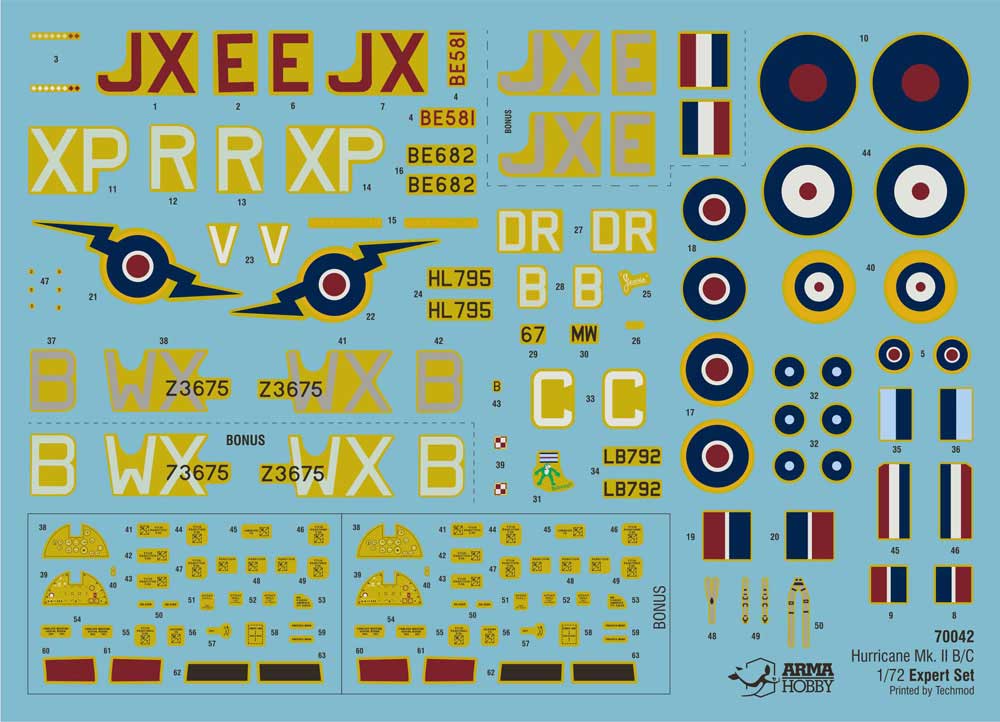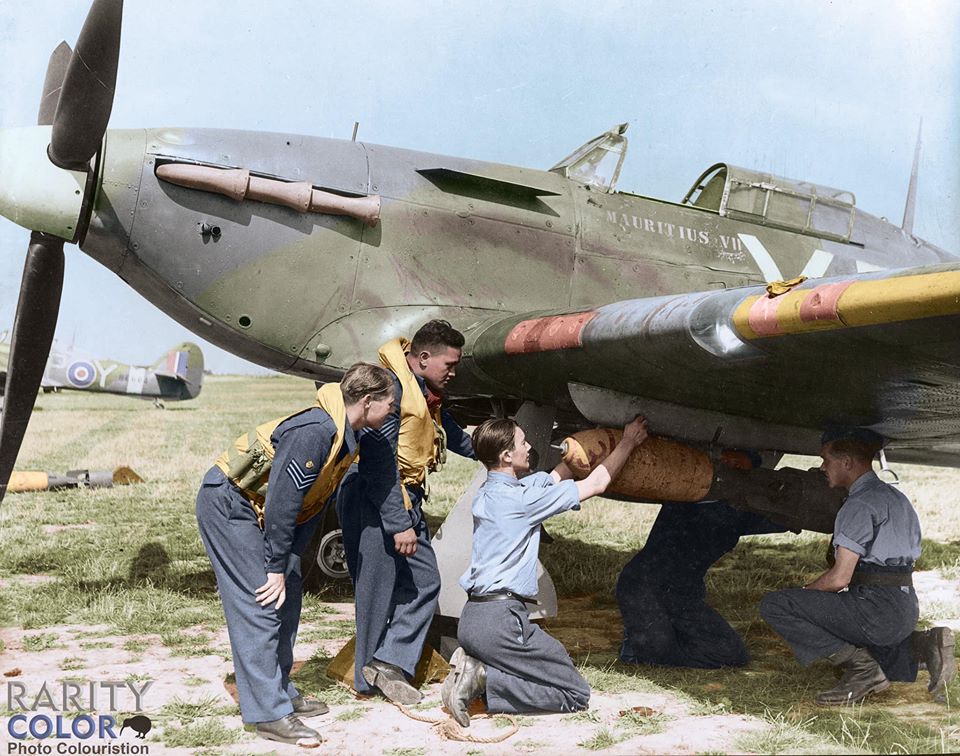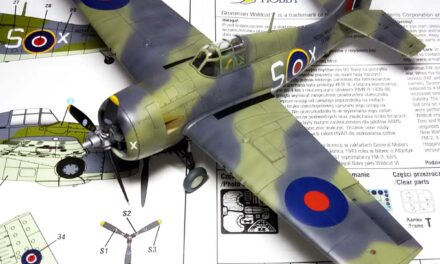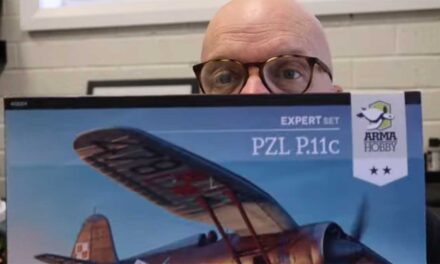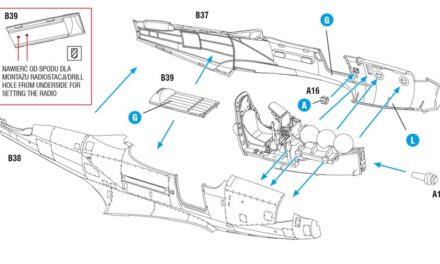One of the most intriguing and well documented Hurricanes Mk IIb is the aircraft BE682 / XP-R from No. 174 Squadron RAF. Thanks to the analysis of available photos, it is possible to reconstruct the details of its markings and changes they underwent during the service. See how the striped Hurribomber looked and changed.
Striped Hurricane “Mauritius VII”
I like the stripes. While browsing the Imperial War Museum online resources, I found a movie (ARY 17-20) showing the machines of No. 174 Squadron during maintenance at the airfield. The film was shot in early July 1942 during the preparation to the Operation Rutter. At that time, characteristic stripes, also known from Polish Spitfires, were painted on the engine cowling and tail. Luckily, our BE682 was in the foreground. We also managed to see a fragment of the starboard in other videos and photos. It had quite a long and noteworthy combat history. On 29th April 1942, ten aeroplanes received the name “Mauritius” with the numbers from I to X. Then a propaganda team appeared and took pictures of the pilots and their planes (CH 5627 et seq. in the Imperial War Museum archives). The aeroplanes still have A1 Type roundels painted on their fuselages, so from the modelling point of view, it is also possible to make the model with an even earlier marking. Maybe one day Arma Hobby will come back to this topic and then we will make another plane from this unit.
Hurricane IIb, BE682/XP-R Mauritius VII with markings from “Operation Rutter” (white stripes on cowling), early July 1942. Artwork by Zbyszek Malicki.
Hurricane XP-R in action
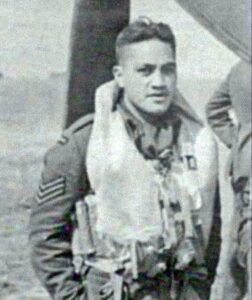 For the first time, Hurricane BE682 appeared in the unit’s ORB on 17th April 1942. One of its pilots was F/Sgt James Himiona Wetere (RNZAF), a Maori born in Hoe-O-Tainui in 1918, who fought in the ranks of No. 174 Squadron and then in No. 184 Squadron on Typhoons. In the latter unit, he was promoted Flight Lieutenant and received the Distinguished Flying Cross (DFC). His distinctive figure appears in many photos. In May and June, P/O Davies made the most flights on BE682. On 30th June at night, he attacked two small ships near Cap Griz Nez. The boxart by Piotr Forkasiewicz is an artistic vision of this event. However, P/O Davies did not observe such a spectacular effect of his attack.
For the first time, Hurricane BE682 appeared in the unit’s ORB on 17th April 1942. One of its pilots was F/Sgt James Himiona Wetere (RNZAF), a Maori born in Hoe-O-Tainui in 1918, who fought in the ranks of No. 174 Squadron and then in No. 184 Squadron on Typhoons. In the latter unit, he was promoted Flight Lieutenant and received the Distinguished Flying Cross (DFC). His distinctive figure appears in many photos. In May and June, P/O Davies made the most flights on BE682. On 30th June at night, he attacked two small ships near Cap Griz Nez. The boxart by Piotr Forkasiewicz is an artistic vision of this event. However, P/O Davies did not observe such a spectacular effect of his attack.
Photo: F/SGT James Himiona Wetere, www.aucklandmuseum.com
No. 174 Squadron flew both day and night missions. It bombed and strafed ground targets (in the RAF code: Rhubarb, Ramrod and Circus operations) and shipping (Roadstead) from level flight and shallow dive. During the day missions, they usually had a Spitfire cover. Later they also used 500lb bombs. The modeller can use bombs from other manufacturers’ Spitfire or Mosquito models.
Hurricane IIb BE682/XP-R piloted by P/O Davies attack German coastal shipping in France, June 1942. Artowrk by Piotr Forkasiewicz.
On 19th August 1942, BE682 was in the Blue section during the squadron’s first patrol during the Operation Jubilee. Sergeant Moore was at the controls then. The ORB records do not mention any damage, but the plane did not take part in subsequent flights. That day the squadron lost as many as three pilots, including the French commander S/Ldr Fayolle, for whom it was the first operation with the unit. Two others were taken prisoners. The squadron lost five planes, and several others were damaged.
Our BE682 appears in the ORB records again on 16th November, when Sergeant Mitchell attacked a freight train with bombs near Le Tréport. Soon the No. 174 Squadron stopped operational flying and in December withdrew for rest, and in April 1943 Typhoons replaced squadron’s Hurricanes. Unfortunately, I have not been able to determine the further fate of our aeroplane.
Designing decals in Arma Hobby
I became a researcher for Arma Hobby while they were developing decals for the 70036 set. My comments were probably convincing because Arma Hobby introduced them. I can proudly say that thanks to my and Zbyszek Malicki’s (Arma Hobby graphic designer) joint efforts, the decals for that set are now more interesting and reflect what we can see in the pictures. Wojtek drew me into further cooperation, and the latest set is, even more, my work, both when it comes to the choice of most of the painting options and camouflage and marking details.
Despite the apparent abundance of information, designing a model is a big challenge, and there are always a few elements missing. We wanted to make decals so good that they would match the quality of the model itself. We decided not to use ready-made fonts, and almost all serial and code letters were drawn by hand, repeatedly corrected, adjusted to the photo and only then saved by Zbyszek in vector graphics. We have tried to reflect the delicate variations and irregularities in hand-painted markings that disappear when the entire design is digitized. In my opinion, the effect is very satisfying, and I hope that the modellers will appreciate this effort.
Notes for modellers:
In this unit, there were no strict rules on how to paint code letters. In the case of BE682, even the letters on both sides of the fuselage differed. In the photos, we can see most of the code on the port side, and only a fragment of the letter P on the starboard. The rest is a reconstruction.
In May 1942 the national markings were changed. As the new C-Type roundel on the underside of the wings was 32 inches in diameter and the old 35 inches, there was a lighter border of fresh paint around it.
- GP (General Purpose) bombs had a light green stripe on the body of the bomb and a red one just behind the fuse. This red element is not on the manual as it would be unreadable.
- The anti-glare blinkers, which protected pilot’s eyes from exhaust glare, on the BE682 had a slightly different shape than those offered in the set, or on the photo-etched parts. They should have a bevelled front and back edge.
- The installation of bomb racks made it impossible to eject the shell cases from the second machine gun efficiently. The temporary solution was removing these machine guns and blocking the muzzles with square plates. The rest of the barrels were covered by separate square pieces of cloth glued with red lead paint.
- For the more ambitious, you can also make a flare shute on the left side of the fuselage, just below the antenna mast. It was often sealed with a round piece of cloth.
Colourised photo of the Hurricane IIb XP-R, Summer 1942. Second from the left: F/SGT James Himiona Wetere. Photo courtesy Rarity Color.
See Also:
Hurricane Mk IIc – myśliwiec na każdą porę, w nocy i w dzień
Model maker for 45 years, now rather a theoretician, collector and conceptual modeller. Brought up on Matchbox kits and reading "303 Squadron" book. An admirer of the works of Roy Huxley and Sydney Camm.
This post is also available in:
 polski
polski





